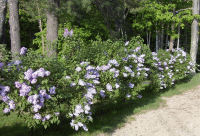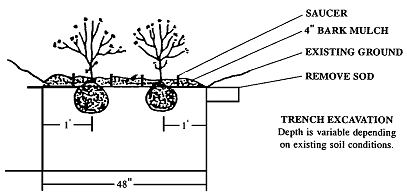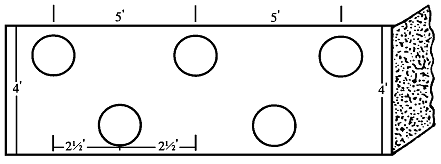Spring planting is recommended in areas with severe winters or on sites that are exposed to harsh winds. Planting in the early spring, together with good care during the first growing season, will result in the strongest plant for survival through a hard winter. Fall planting (August 15 – October 15) can be considered in areas with mild winters. Lilac roots will grow until the ground is frozen so fall planting will give added root establishment to support growth in the top of the plant.
 The amount of work required to plant a lilac will depend on the soil condition. A good rule is to have the soil tested and if it is low in pH or fertility, the whole area can be adjusted before planting. It is always better to treat the area than to try to modify only the planting hole. The latter can create a "pot" situation where roots will circle in the hole and eventually cause strangulation.
The amount of work required to plant a lilac will depend on the soil condition. A good rule is to have the soil tested and if it is low in pH or fertility, the whole area can be adjusted before planting. It is always better to treat the area than to try to modify only the planting hole. The latter can create a "pot" situation where roots will circle in the hole and eventually cause strangulation.
Drainage is also best handled on an area basis. A "pot hole" dug in pure clay will fill with water and drown the plant put in it. Lilacs are sensitive to wet soils so there must be good drainage if they are to survive. To do the actual planting, dig a hole big enough to accommodate the roots without bending or breaking them. If an organic fertilizer such as bone meal is used, it should be mixed with the planting soil since surface applications move down to the roots very slowly. Set the plant at the same level that it grew in its previous site and work the topsoil in around the roots. If the plant is grafted, the graft union, which is located near the old soil line, should be below the soil line. However, if the roots are set more than 2 to 3 inches lower than their original setting the plant will be slow to establish and the roots may die from lack of oxygen. After working in the topsoil, fill the hole with water and let it drain away. This will settle the soil around the roots and collapse air pockets. Then add more topsoil to the final level. A small saucer dam can be set up around the root zone so that subsequent waterings will stay in the root area. A mulch of straw, bark, or stone around the plant will help to reduce weeds, to retain moisture and to prevent frost heaving.
Keeping the area around the newly set plant free from other vegetation will dramatically speed its establishment. Weeds, tall grass, or even lawn grass close to the newly planted lilac will win the competition for water and food. The result will be a very weak plant that grows slowly for several years. There should be at least one foot cleared space around the new lilac, but even more is desirable.
The soil moisture level in the first growing season is very important. Drought stress, even for a short time, will severely restrict new shoot growth and retard plant establishment. Lilacs are slow growers for the first year or two after planting and neglect during the first year will make this even more evident.
Fall Planting
Fall planting can be recommended in any area that does not have a severe winter. By August, the top of the plant has completed its growth and produced winter buds that are dormant. The roots, however, can continue to grow until the ground freezes. The biggest problem in the fall planting is the possibility of drought conditions. Summer moisture in New England comes mainly from showers that can fall late in summer or by-pass a particular location. Dry soil will delay root regeneration and, if severe enough, can kill the plant. A reliable watering so that it is not water stressed will prevent the problem and go a long way toward making a fall planting successful.
In northern New England the time from August 15th to September 30th is best because there is still a long period for root growth. Later plantings, thru October, can be considered but the later the planting, the greater the chance for winter kill if the winter is severe or has a thin snow cover. A mulch of wood chips or bark 3” thick will protect the plants in the winter and retain soil moisture in the summer. Mulch retards the growth or weeds and grass but still allows the lilac plant to sprout.
Whether one is moving a lilac from place to place or buying a new balled and burlapped or container grown plant, the procedure for planting is the same as for spring planting. Use top quality plants and dig a hole with surrounding soil so that the roots can grow out without hindrance. The only difference from spring planting is that real care must be taken to prevent drying during or after planting. A newly acquired plant left in a closed car in a parking lot can be cooked as quickly as the family pet. Also, a plant dug from one location and left unplanted in the hot sun can suffer severe root damage from dryness in a matter of hours. After planting, watering should be considered on a regular basis whenever natural rain is inadequate and should continue until a hard freeze occurs.
Many people like to plant in the early fall. They are not as busy as in the spring and frequently the weather is much nicer for outdoor activities. It is also a time when plants still have their leaves and the effect of a newly set plant can be seen immediately.
REMEMBER, WHENEVER POSSIBLE LOCATE AN AREA WITH FULL SUN EXPOSURE, THE MORE SUN THE BETTER!
Trench Method Planting:
When space permits and a mass planting or hedgerow is desired, good results can be realized by using the trench method of planting (see typical below). This method allows for ample enriched soil for vigorous plant growth and easy maintenance. Plants set 5’ on center with a second alternate row results in good sprouting thus soon eliminating grass and weeds. A bed 4 feet wide, 2 feet deep and 25 feet long involves slightly less than 8 cubic yards of loam. This amount will accommodate 10 plants. The planting detail can be altered to use 3 rows by changing the width to 6 feet. Competition with grass is reduced by removing approximately 3 inches of sod depth and 1 foot wide around the perimeter of the bed and then filling this area with mulch.
 |
Figure 1 - Side View. Plant in two staggared rows. NOTE: Soil should be tested to determine what nutrients may or may not be NECESSARY.
|
 |
| Figure 2 - Top View. Plant in two staggared rows. Note: A-50’ long trench 4’ wide and 5’ spacing 2-rows accommodates 21 plants. A-30’ long trench 6’ wide 5’ spacing 3 rows accommodates 20 plants. |
Propagation
Lilacs can be propagated from offshoots (commonly called suckers) and by cuttings, grafting, budding, layering, and seed. The choice will depend on the plant and the skill of the propagator.
The simplest way to obtain true-to-name lilacs is to dig up offshoots from the base of an established own-root plant. If the plant is a grafted one, this won’t be true because the base (the roots) will be a different type from the top. It may not be easy to tell a grafted plant, but if offshoots have a different shaped leaf or if older offshoots produce different colored flowers, chances are that the plant is grafted. However, if the plant is on its own roots and does produce offshoots, this method is easy and has a good chance of success.
The process is best done early in the spring before new growth or in late summer after all the season’s growth has been completed. With something like a sharp shovel, cut the underground stem that joins the offshoot to the parent plant. Carefully lift the offshoot, trying to retain as many roots as possible, and transfer it to a place where it can receive good care for its first independent year. This could be in the permanent new location if the small size will not cause it to be overlooked or neglected, but the safer route is to put the newly separated offshoots in a nursery row, perhaps along the vegetable garden or at the back of the flower garden where they can be weeded and watered for the first critical year. Competition from grass or weeds and lack of regular water supply will dramatically slow down plant establishment. The most vigorous can be moved out the next spring and the others left in the nursery for a second year.
Lilac Companion Plants
Lilacs possess a beauty both outstanding and unique! The masses of color, bloom and their captivating fragrance are one of the focal points of Springtime wherever they can be grown. For this reason they are ideal "focal" plants on their own. However, like a diamond in an exquisite setting they are enhanced by many varieties of "companion plants". Some plants are particularly suited either by their form, background color, their bloom or compatibility and harmony to be grown together with lilacs. We shall consider only a few of the most outstanding that form works of landscape artistry when grown together with lilac. You may have your own special companions to your lilacs – by all means continue to grow them together as you consider some of the combinations others have used most successfully.
- Flowering Crabs
- Flowering Dogwood
- Flowering Cherries
- Peonies
- Showy Magnolias
- Hosta
next: Care and Maintenance...
